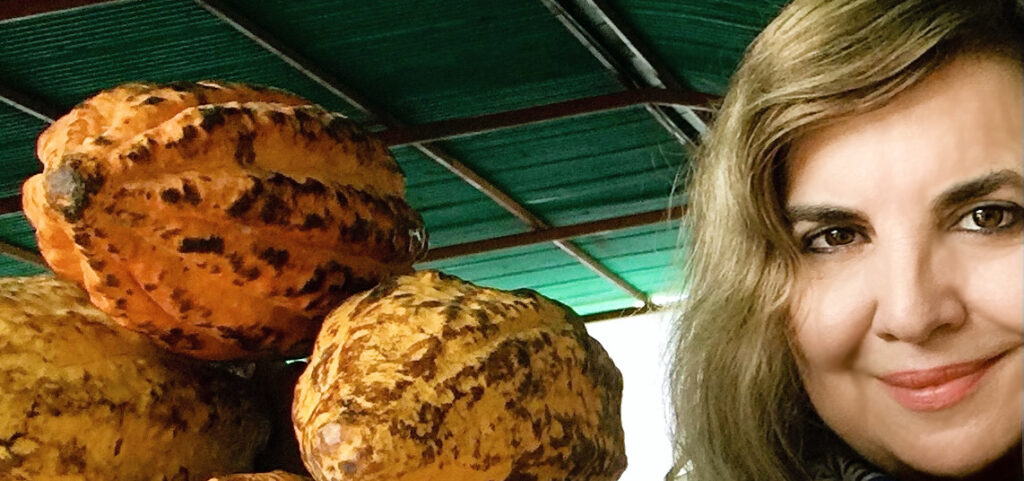In May our members embarked on a delicious journey through the world of award-winning chocolate, guided by one of the industry’s most notable experts. Dr. Maricel Presilla, co-founder and Americas Director of the International Chocolate Awards, joined us for an unforgettable tasting session featuring five craft chocolate bars that have earned recognition at this prestigious global competition.

Before we delve into the chocolate, it’s worth understanding the depth of knowledge our expert guide brings to the table. Dr. Presilla is not just a casual chocolate enthusiast. She is a culinary force whose connection to cacao runs deep. As a descendant of cacao farmers from eastern Cuba, she has a personal connection to chocolate that began in childhood, where she first experienced cacao as a fruit growing in sustainable harmony with other crops.
Her formal credentials are equally impressive. Trained in Spanish and Latin American history with a PhD from New York University, Dr. Presilla combines rigorous academic standards with extensive fieldwork. Her seminal book, The New Taste of Chocolate: A Cultural and Natural History of Cacao with Recipes (revised edition), was groundbreaking in its visual presentation of cacao varieties and their flavor profiles. As an award-winning author, culinary historian, chef, and restaurateur, she has established herself as a preeminent expert on Latin American cuisines, cacao, and chocolate.
In 2011, Dr. Presilla co-founded the International Chocolate Awards, now the largest independent fine chocolate competition in the world, judging over 3,000 chocolate entries across nearly 30 categories annually. This platform has allowed her to develop exceptional tasting skills and gain unique insights into chocolate styles, trends, and market opportunities worldwide.
The International Chocolate Awards was created to provide a platform for small chocolate makers who might otherwise struggle to compete against larger companies. What began as an idea in the Peruvian Amazon has grown into a global competition with regional events across the world and an annual world final.
Dr. Presilla oversees the Americas region, handling entries from Canada to Patagonia and throughout the Caribbean. The process involves meticulous preparation, with samples being processed by a dedicated team and sent to judges worldwide. Winners of these awards gain valuable recognition that helps propel their brands forward in the competitive chocolate market.
Before diving into our first bar, Dr. Presilla shared her approach to chocolate tasting. She uses a methodology that reveals the true complexity of fine chocolate:
“The unexamined chocolate is not worth eating,” she explained, emphasizing the importance of understanding the maker, examining the chocolate’s appearance, and assessing its aroma before tasting.
When examining a chocolate bar, Dr. Presilla looks for:
When tasting, she recommends focusing on five fundamental tastes first – acidity, sweetness, bitterness, umami, and saltiness – before moving on to more nuanced flavors. This structured approach helps tasters develop what she calls a “library of archetypes”, flavor memories that serve as reference points for describing chocolate’s complex characteristics.
Our tasting began with Fruition’s Colombia Tumaco, an 85% dark chocolate bar with a striking deep color that immediately caught Dr. Presilla’s attention.
Upon tasting, she detected a pronounced acidity with “oxalic” qualities reminiscent of rhubarb and green tamarind. This initial brightness was followed by robust bitterness, a pronounced cacao center, and a drying astringency that lingered pleasantly.

Dr. Presilla explained that this complexity stems from the diverse genetic makeup of Tumaco cacao, which includes Amelonado, Iquitos, Contamana, and traces of Criollo varieties. She noted that while the 85% formulation showcases the cacao’s powerful character, a 70% version would likely express more dried fruit notes like prunes and raisins, while a milk chocolate version would “iron out those rough edges” to create a fantastic, powerful milk chocolate.
The bar’s maker, Fruition Chocolate Works, is a husband-and-wife operation based in upstate New York that Dr. Presilla holds in high regard. The cacao for this bar comes through a supply chain that begins with Cacao Hunters in Colombia, a company founded by Japanese chocolate maker Mayumi Ogata, who has worked extensively with small-scale Black farmers in the Tumaco region.
Our second bar came from Sleepwalk, a Chicago-based company that began as a coffee roaster called Dark Matter. Dr. Presilla was particularly excited to share this chocolate, as it represents the discovery of emerging talent, one of her favorite aspects of the International Chocolate Awards.
“These are Mexican Americans who go to mostly Mexico and Guatemala to get both coffee and cacao,” she explained. “They have the sensibility of coffee traders. They’re looking for specialty, and I think they’re doing great work.”
The bar’s name, Blanco Jaguar, refers to the white-beaned cacao variety known as Almendra Blanca from Chiapas, Mexico. Dr. Presilla took this opportunity to dispel a common misconception about this cacao from Chiapas. Despite its white beans, this is not pure Criollo cacao but rather a hybrid that retained the white color while incorporating other genetic influences.
When tasted, the Blanco Jaguar revealed a remarkable burst of bright, juicy fruit flavors including strawberry, raisins, and citrus notes, accompanied by green acidity and balanced with gentle bitterness. Several participants noted a distinct heat sensation at the back of the throat, which Dr. Presilla explained is not capsaicin (as cacao doesn’t contain it) but rather a sensation created by the cacao’s natural astringency.

The group discussion revealed that some members’ bars were stamped with different origin marks on their chocolate bars. Some were marked “ORD MEX” (Chicago and Mexico) and others were marked “NYC MEX” (New York City). Sleep Walk recently opened a cafe in Manhattan and is making chocolate in both locations.
Our third selection came from Piety and Desire, a New Orleans-based chocolate maker whose name reflects the city’s cultural heritage. This innovative 73% dark chocolate bar features nibs soaked in stout beer from Parleaux Beer, along with hazelnuts and vanilla.
Nick Xidis, a chocolate maker and club member, shared insights into the technical challenges of creating such a bar: “You have to winnow the beans to turn them into nibs and then soak the nibs for 2-3 days. Then, before you refine the nibs, you’ve got to get the moisture down to 6 or 7%. It actually makes a large difference how quickly you dry them out… if you dry really fast, it tends to capture a lot more of the alcohol flavors.”
The tasting revealed a remarkable complexity. While some participants detected citrus acidity, others noted malty flavors characteristic of stout beer. Estelle, who conducts beer and chocolate pairings, identified hoppy notes that were balanced by sweetness rather than overwhelming bitterness.
“I’ve never had anything that tastes like this before,” Estelle remarked. “I thought this was very unique.”

Dr. Presilla was pleased with the bar’s balanced profile, noting the presence of floral notes alongside the malt and hop characteristics. The vanilla, she observed, served as “a good mother telling all flavors to behave,” helping to round out the chocolate’s complex flavor profile.
Our fourth selection shifted to dark milk chocolate. This 63% Sierra Nevada bar from Castronovo represents what Dr. Presilla calls “cortadito chocolates,” referencing the Cuban coffee with a touch of milk.
Denise Castronovo, the chocolate maker behind this bar, runs a family business in Florida with a strong focus on conservation and direct relationships with cacao farmers. Dr. Presilla, who has taught Castronovo in her chocolate courses, praised her work while noting she has sometimes guided her toward gentler roasting techniques.
The tasting revealed a chocolate with remarkable balance. The milk perfectly complemented the assertive cacao without overwhelming it. Members detected notes of white peach, butter, toffee, and caramel. The Sierra Nevada cacao, which comes from Colombia, contains a complex mixture of genetic varieties including Iquitos, Nanay, Amelonado, and Trinitario influences.

“This is a milk chocolate with personality,” Dr. Presilla declared. “There is nuts, I feel dry fruit right there, but I feel also cacao, and it’s assertive, but it’s very round, but it has a lot of complexity.”
When asked what indicates a truly delicious chocolate, Dr. Presilla offered a simple test, “I want another piece. When you want a second or a third piece, that should tell you something.”
Our final selection was a two-tone bar from Rhyme and Reason in North Carolina that combined passionfruit infused white chocolate on top of dark chocolate from Ecuador. Chief Chocophile, Lauren Adler, suggested tasters place the dark chocolate side on their tongue to ensure the passionfruit flavors didn’t overwhelm the dark chocolate.
Dr. Presilla took the opportunity to discuss Ecuador’s complicated cacao situation. Once famous for the floral Nacional variety with its distinctive jasmine notes, Ecuador now grows significant quantities of CCN-51, a productive but less flavorful hybrid. This shift has created challenges for chocolate makers seeking authentic Ecuadorian flavor profiles.
The dominant impression of this bar was the assertive passion fruit flavor, which Dr. Presilla described as “rounding up everything… it’s like having a Maracuya milkshake.” Club members agreed, with one noting “it pops up passion fruit!” and another suggesting it would pair beautifully with a sour beer.
Dr. Presilla concluded our tasting with valuable advice for developing a sophisticated chocolate palate.
“If you’re serious, you have to go deep. You have to take courses. You have to taste with a group of people, just so that you can have an exchange of ideas. You have to do it on your own, and you have to smell and taste everything.”
She emphasized the importance of building a “library of archetypes” by experiencing a wide range of flavors in their natural form. Rather than relying on artificial flavor references, she recommends seeking out and tasting the actual fruits, spices, and other ingredients that might appear in chocolate flavor profiles.
“You have to become like the hounds of flavor and aroma,” she advised. “You have to go to the market and smell everything, and you have to build a library of archetypes. If you don’t have a good library of archetypes of flavor, you can’t express. You cannot describe the complexity of a chocolate.”
If you’d like to follow her advice, check out the certification classes offered by the International Institute of Chocolate & Cacao where she teaches. They offer classes around the world, including some in cacao-growing countries where you’ll be able to expand your library of archetypes with local foods.
At The Chocolate Explorers Club™ we bring together chocolate enthusiasts with world-class experts to explore the delicious, rich stories of specialty chocolate. Each month, our members receive carefully curated selections delivered to their doors, along with opportunities to participate in live tasting events like this one. We invite you to join us on a flavorful journey of discovery.
